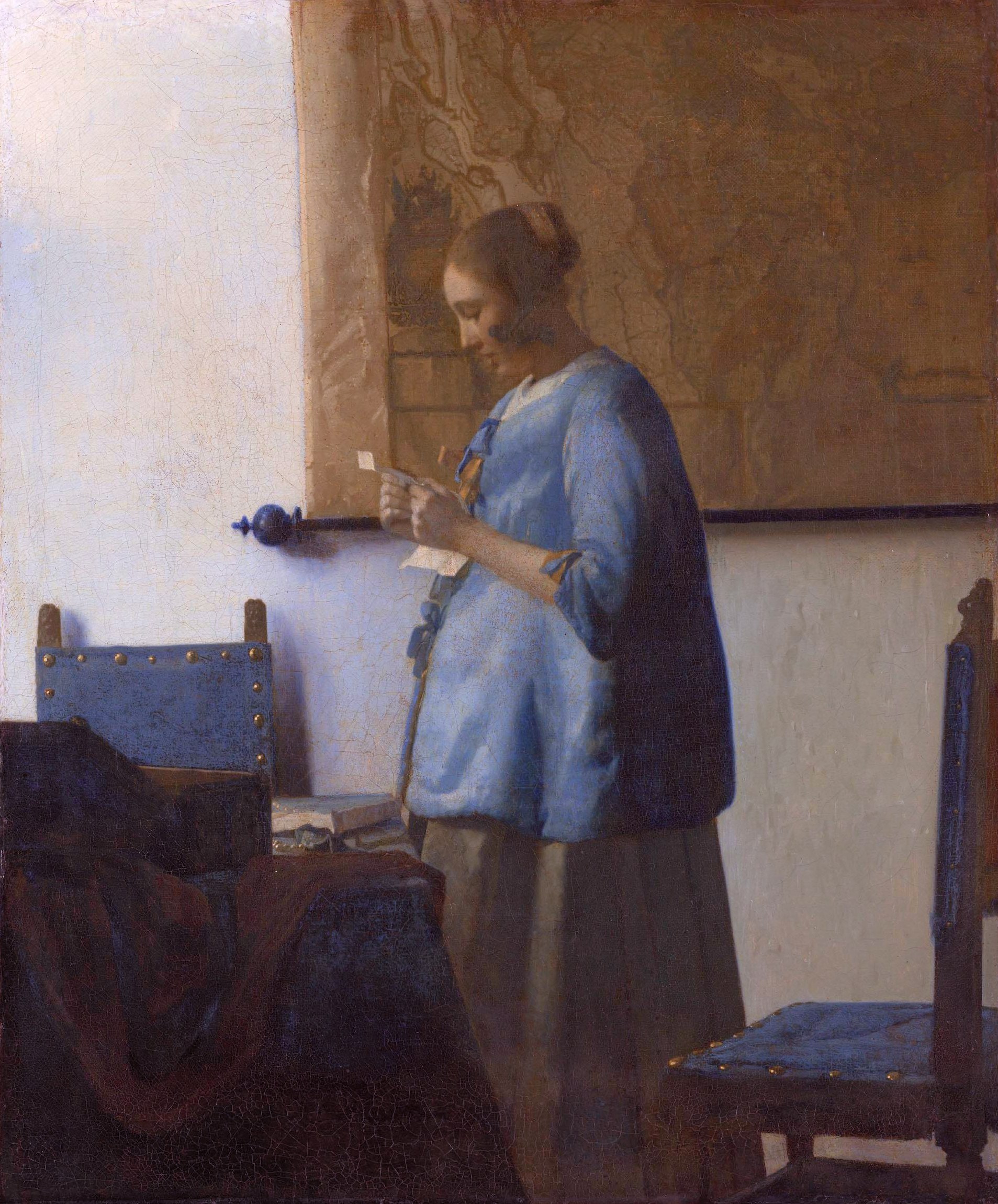
Vermeer and the Masters of Genre Painting review – the birth of the cool
Louvre, Paris
Vermeer exhibitions are often padded out with his lesser peers – but here, fine choices illuminate the staggering soulfulness of the Dutch master
Jonathan Jones
Tuesday 21 February 2017
Some artists are so dazzling they reduce all around them to greyness. Their genius is a flame for us moths who queue for hours to see any exhibition with their name on it.


But what about all the other artists in this exhibition – those “Masters of Genre Painting”? Are they left looking stupid next to the genius from Delft? For every Vermeer in this blockbuster there are several paintings by his 17th-century Dutch contemporaries such as Gerard ter Borch, Nicolaes Maes and Gerrit Dou. So it goes with Vermeer exhibitions. His output was small and his paintings are treasures; even when the selection of his paintings is as fine as it is here, it needs fleshing out, just to make up the numbers. All too often, this results in frustrating shows where you move on past minor paintings to get to the next pearl by Vermeer.
So where Vermeer and the Masters of Genre Painting truly leaps into a league of its own is by making you look at, and appreciate, the “lesser” lights of 17th-century Dutch art. They only look lesser when you set them next to Vermeer – and this brilliantly chosen exhibition casts even that into doubt.
Vermeer is one the most acute painters of everyday life who has ever lived, yet his fascination with domestic scenes was not unique among his rivals. It was not even original. He is one of many Dutch artists in the 1600s who rejected the big, noisy stuff of traditional art – battles, myths, martyrdoms – and preferred to paint a man offering a woman a drink, a servant watching while her mistress writes a letter, a doctor making a diagnosis: episodes that take place not in palaces but canalside merchant houses.
The title of this exhibition uses the traditional name for this art that would have been used by Joshua Reynolds in the 18th century or John Ruskin in the 19th: “genre” painting. This slightly dismissive term reflects the fact that long after they were created, these radically realist paintings were seen as vulgar and trivial compared with a noble portrait of a king on horseback or a vision of the Olympian gods.
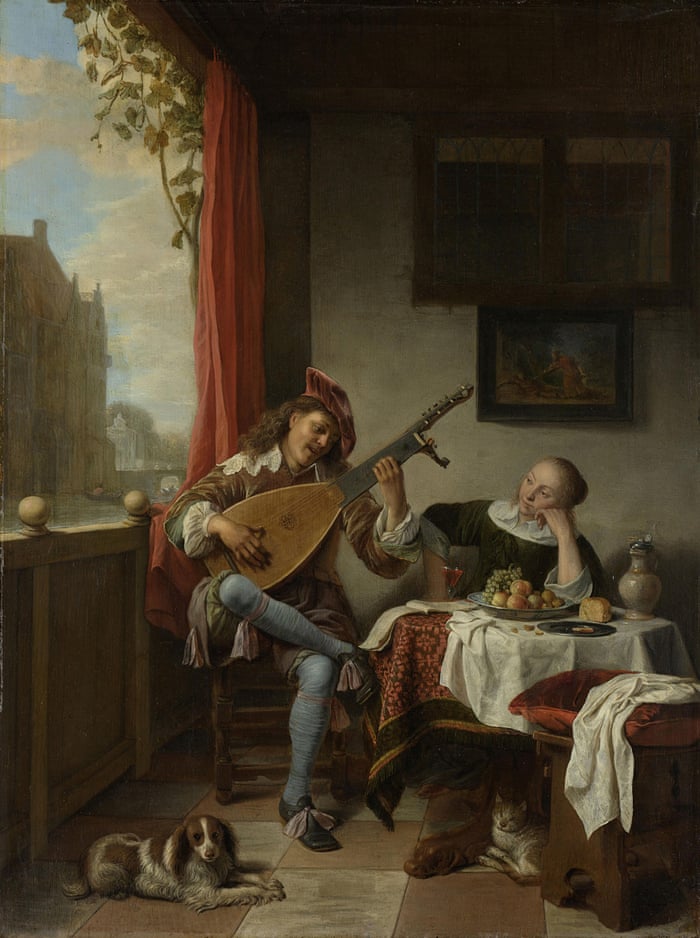
Hendrik Maertensz Sorgh - The Lute Player, 1661
In Hendrick Martensz Sorgh’s The Lute Player (1661), a woman listens languidly while a man plays his lute for her at a table laden with fruit. The room they are in opens onto a sunny canal, and the summer mood is sensual. A dog looks at us out of the painting, sharing its cynical view of this flirtatious situation. And that’s it. The drama is implied, not shown. Maybe we’re witnesses to adultery, while her husband is away on business. May it’s just an innocent music lesson.

Gerrit Dou - La Cuisiniere Hollandaise, c.1640 - 1650
Such paintings of everyday moments turn the drama of art inward, and make it hesitant, uncertain, complex. Right and wrong are not obvious. There are no dragons. Ter Borch’s Officer Writing a Letter (c.1658-59) is a quiet moment from military life. While the officer concentrates on his writing, a soldier waits with a brooding look on his face. Is it a love letter the long-haired officer is writing, or news of a defeat?
Vermeer and the Masters of Genre Painting gets away from the idea that used to be overdone by art historians, that every Dutch Golden Age painting has a clear moral. Far from warning in flashing lights against drinking with men or having secret lovers, these are paintings that tell deliberately unfinished and unresolved stories.

Gabriel Metsu - Young Man Writing a Letter, c.1664 - 66
They tend to have women as their central characters. More clearly than ever before, this exhibition reveals the feminisation of art in 17th-century Holland. Genre painters take us into the domestic world, behind the windows of merchant houses, into the spaces in which women spent their lives 300 years ago. We see something like the reality of women’s lives in the past as a doctor takes a young mother’s pulse, while a clock ticks away the hours of life, or a woman concentrates on domestic work in Maes’s painting Young Woman Sewing (1655).
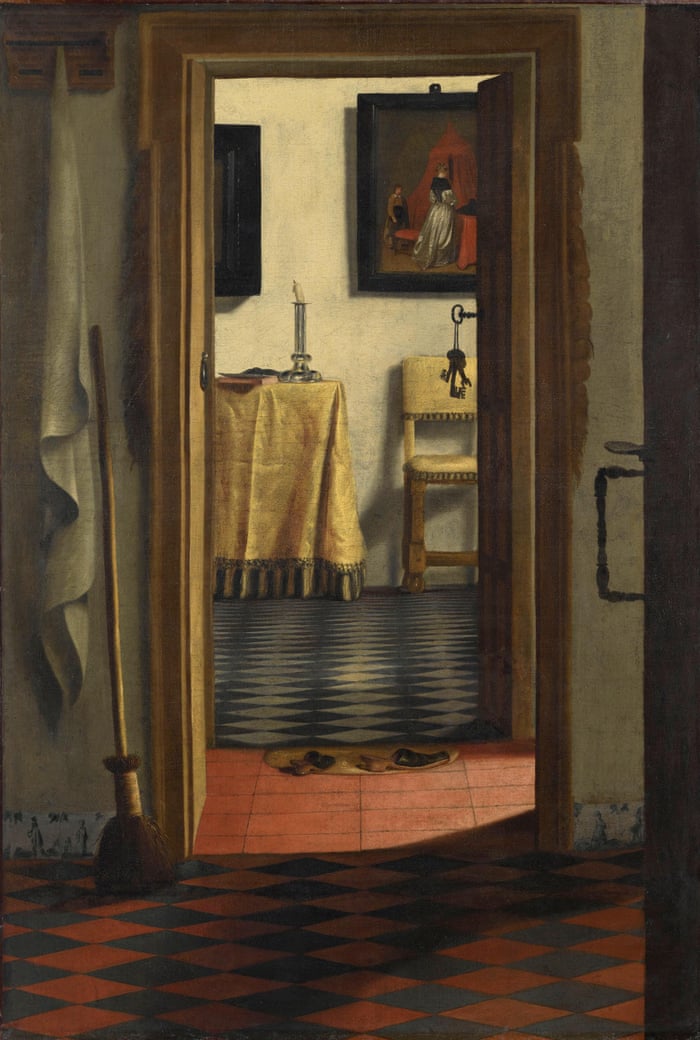 Samuel van Hoogstraten, The Slippers, aka View of an Interior, c.1655 - 62
Samuel van Hoogstraten, The Slippers, aka View of an Interior, c.1655 - 62
The most radically realist painting here is not by Vermeer. It is Samuel van Hoogstraten’s View of an Interior (c.1655-62), in which we look through an open door into a tiled room where a painting by Ter Borch hangs on a white wall above a white chair. We are inside the servants’ quarters. There is a broom propped up in the shadows. Hoogstraten reveals the reality of a Dutch house as he gives us a servant’s perspective on its domestic perfections.
So what marks out Vermeer? Does he just become one of the crowd, after all? On the contrary. By rooting him in his age this exhibition reveals his true distinction.

Lady Writing a Letter with her Maid, 1670
Some people (including David Hockney) think he used a camera obscura or other early optical device to make his pictures that much more real, and it’s not impossible. In his great Woman with a Lute, the furniture in the foreground is seen in deep shadow, while bright light, as bright as the image in a camera obscura, illuminates the young woman’s face, collar and earring. She practically shines. Are these intense yet subtle contrasts of light the kinds of effects Vermeer noticed when using a camera-like device?
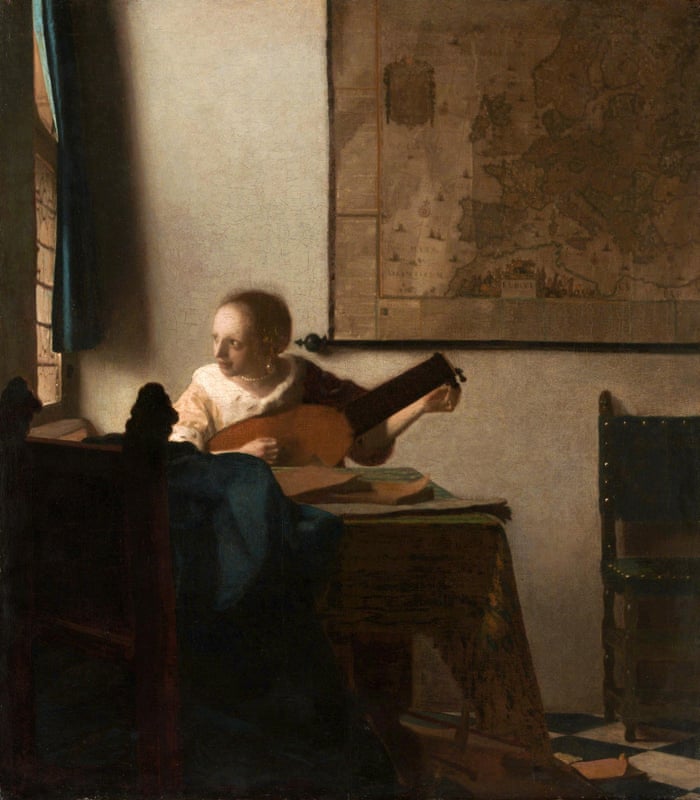
Johannes Vermeer - Woman with Lute, 1663
Maybe, but he’d still have to create those blues and yellows, greys and silvers on his brush. Vermeer’s colours are purer and stranger than those of his rivals; he uses his own poetic palette of sensually cool tones that create a deeper, more enigmatic mood. For the distinction of Vermeer is not just technical or optical. That’s why a secret camera seems such a poor explanation for his art. His paintings have an extra dimension of soul. Far from observing the visible world more acutely than his contemporaries, he looks beyond it more insightfully than they do. Time and again, comparing his paintings with similar scenes by other Dutch artists in this majestic display, it is the greater sympathy and imagination of his art that leaps out. Other artists can show women playing lutes, their faces fixed on sheet music. Only Vermeer can show us the inner life of his lutenist as she looks poignantly into the silver light from the window, thinking of a world beyond, waiting for news from a lover perhaps. On the wall above her hangs a meticulously painted map, showing ships on the North sea and Atlantic. Is her lover or husband off trading in Asia, or London, or Muscovy? All she can do is wait, and play sad music.
Her face is so expressive, so full of light. It is the human depth of Vermeer that is utterly confounding. Like Van Hoogstraten he looks beyond the well furnished quarters of the house into the less than spotless kitchen where a servant patiently pours milk out of an earthenware jug. Her face is a disciplined mask, her eyes downcast. Her name will be forgotten by history. Yet Vermeer sees her, and makes us see her, as so much more than she is allowed to be. History does not happen on the battlefield. It happens in the kitchen, before the master of the house is even up for breakfast.
Louvre, Paris
Vermeer exhibitions are often padded out with his lesser peers – but here, fine choices illuminate the staggering soulfulness of the Dutch master
Jonathan Jones
Tuesday 21 February 2017
Some artists are so dazzling they reduce all around them to greyness. Their genius is a flame for us moths who queue for hours to see any exhibition with their name on it.

Johannes Vermeer - Woman Holding a Balance, c.1664
Vermeer and the Masters of Genre Painting, which opens this week at the Louvre, was already jam-packed when I went to see it and that was two days before the general public was allowed in. No wonder. This is a unique chance to see some of Vermeer’s most stupendous masterpieces in one place – about a third of his entire surviving output, including such glories as The Milkmaid (c.1660), lent by the Rijksmuseum in Amsterdam, Woman Holding A Balance (c.1664) from the National Gallery of Art in Washington DC, and the marvellous Woman with a Lute (c.1662-63) from the Metropolitan Museum of Art, New York.
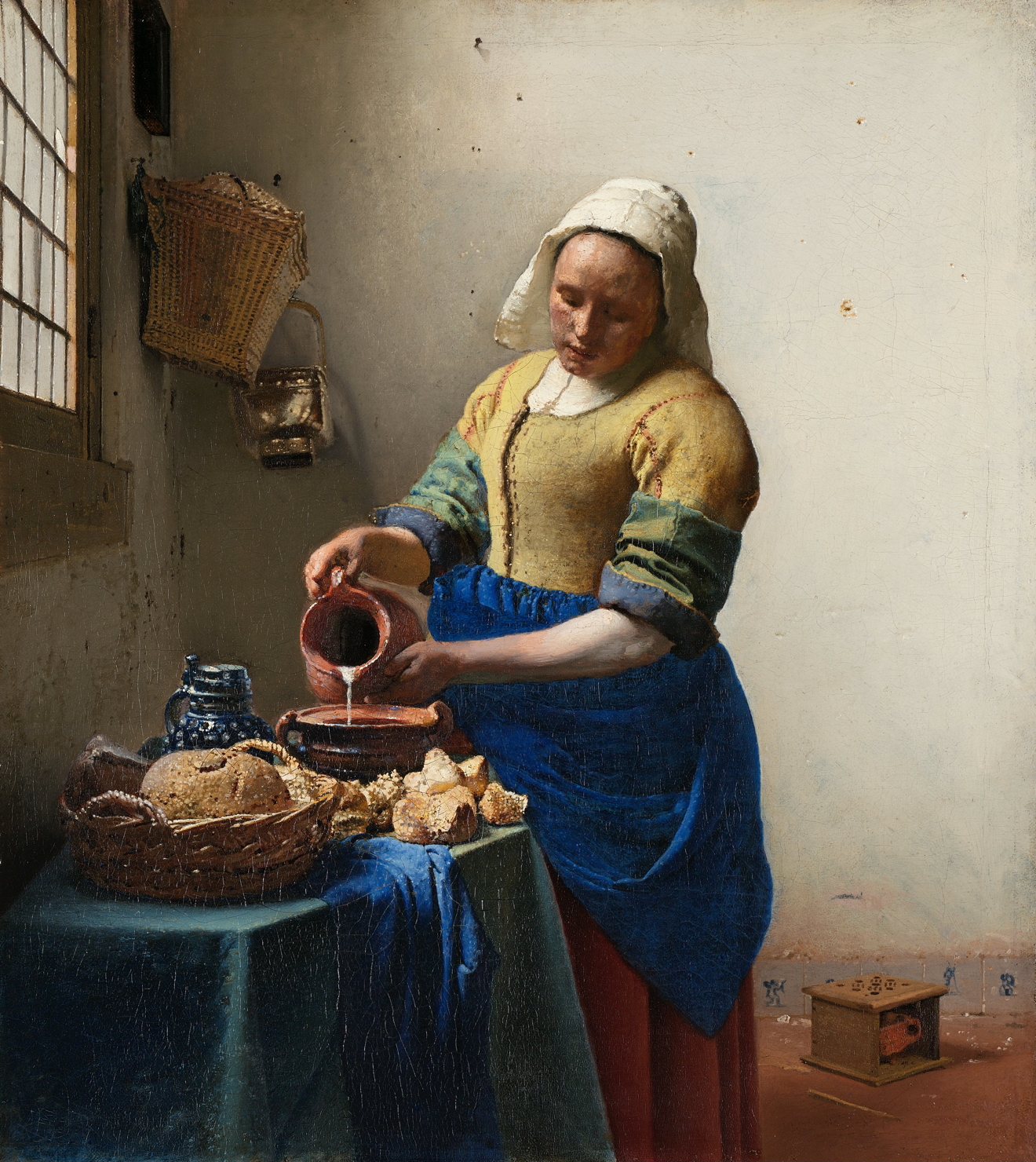
Johannes Vermeer - The Milkmaid, c.1660
This is by far the biggest and best array of Vermeer’s precious paintings that I have seen in any exhibition, and it makes the show a must for anyone who has ever been entranced by his poetic moments of inner drama.

Johannes Vermeer - The Milkmaid, c.1660
This is by far the biggest and best array of Vermeer’s precious paintings that I have seen in any exhibition, and it makes the show a must for anyone who has ever been entranced by his poetic moments of inner drama.

Johannes Vermeer - The Lacemaker, c.1669 - 70
But what about all the other artists in this exhibition – those “Masters of Genre Painting”? Are they left looking stupid next to the genius from Delft? For every Vermeer in this blockbuster there are several paintings by his 17th-century Dutch contemporaries such as Gerard ter Borch, Nicolaes Maes and Gerrit Dou. So it goes with Vermeer exhibitions. His output was small and his paintings are treasures; even when the selection of his paintings is as fine as it is here, it needs fleshing out, just to make up the numbers. All too often, this results in frustrating shows where you move on past minor paintings to get to the next pearl by Vermeer.
So where Vermeer and the Masters of Genre Painting truly leaps into a league of its own is by making you look at, and appreciate, the “lesser” lights of 17th-century Dutch art. They only look lesser when you set them next to Vermeer – and this brilliantly chosen exhibition casts even that into doubt.
Vermeer is one the most acute painters of everyday life who has ever lived, yet his fascination with domestic scenes was not unique among his rivals. It was not even original. He is one of many Dutch artists in the 1600s who rejected the big, noisy stuff of traditional art – battles, myths, martyrdoms – and preferred to paint a man offering a woman a drink, a servant watching while her mistress writes a letter, a doctor making a diagnosis: episodes that take place not in palaces but canalside merchant houses.
The title of this exhibition uses the traditional name for this art that would have been used by Joshua Reynolds in the 18th century or John Ruskin in the 19th: “genre” painting. This slightly dismissive term reflects the fact that long after they were created, these radically realist paintings were seen as vulgar and trivial compared with a noble portrait of a king on horseback or a vision of the Olympian gods.

Hendrik Maertensz Sorgh - The Lute Player, 1661
In Hendrick Martensz Sorgh’s The Lute Player (1661), a woman listens languidly while a man plays his lute for her at a table laden with fruit. The room they are in opens onto a sunny canal, and the summer mood is sensual. A dog looks at us out of the painting, sharing its cynical view of this flirtatious situation. And that’s it. The drama is implied, not shown. Maybe we’re witnesses to adultery, while her husband is away on business. May it’s just an innocent music lesson.

Gerrit Dou - La Cuisiniere Hollandaise, c.1640 - 1650
Such paintings of everyday moments turn the drama of art inward, and make it hesitant, uncertain, complex. Right and wrong are not obvious. There are no dragons. Ter Borch’s Officer Writing a Letter (c.1658-59) is a quiet moment from military life. While the officer concentrates on his writing, a soldier waits with a brooding look on his face. Is it a love letter the long-haired officer is writing, or news of a defeat?
Vermeer and the Masters of Genre Painting gets away from the idea that used to be overdone by art historians, that every Dutch Golden Age painting has a clear moral. Far from warning in flashing lights against drinking with men or having secret lovers, these are paintings that tell deliberately unfinished and unresolved stories.

Gabriel Metsu - Young Man Writing a Letter, c.1664 - 66
They tend to have women as their central characters. More clearly than ever before, this exhibition reveals the feminisation of art in 17th-century Holland. Genre painters take us into the domestic world, behind the windows of merchant houses, into the spaces in which women spent their lives 300 years ago. We see something like the reality of women’s lives in the past as a doctor takes a young mother’s pulse, while a clock ticks away the hours of life, or a woman concentrates on domestic work in Maes’s painting Young Woman Sewing (1655).

The most radically realist painting here is not by Vermeer. It is Samuel van Hoogstraten’s View of an Interior (c.1655-62), in which we look through an open door into a tiled room where a painting by Ter Borch hangs on a white wall above a white chair. We are inside the servants’ quarters. There is a broom propped up in the shadows. Hoogstraten reveals the reality of a Dutch house as he gives us a servant’s perspective on its domestic perfections.
So what marks out Vermeer? Does he just become one of the crowd, after all? On the contrary. By rooting him in his age this exhibition reveals his true distinction.
Lady Writing a Letter with her Maid, 1670
Some people (including David Hockney) think he used a camera obscura or other early optical device to make his pictures that much more real, and it’s not impossible. In his great Woman with a Lute, the furniture in the foreground is seen in deep shadow, while bright light, as bright as the image in a camera obscura, illuminates the young woman’s face, collar and earring. She practically shines. Are these intense yet subtle contrasts of light the kinds of effects Vermeer noticed when using a camera-like device?

Johannes Vermeer - Woman with Lute, 1663
Maybe, but he’d still have to create those blues and yellows, greys and silvers on his brush. Vermeer’s colours are purer and stranger than those of his rivals; he uses his own poetic palette of sensually cool tones that create a deeper, more enigmatic mood. For the distinction of Vermeer is not just technical or optical. That’s why a secret camera seems such a poor explanation for his art. His paintings have an extra dimension of soul. Far from observing the visible world more acutely than his contemporaries, he looks beyond it more insightfully than they do. Time and again, comparing his paintings with similar scenes by other Dutch artists in this majestic display, it is the greater sympathy and imagination of his art that leaps out. Other artists can show women playing lutes, their faces fixed on sheet music. Only Vermeer can show us the inner life of his lutenist as she looks poignantly into the silver light from the window, thinking of a world beyond, waiting for news from a lover perhaps. On the wall above her hangs a meticulously painted map, showing ships on the North sea and Atlantic. Is her lover or husband off trading in Asia, or London, or Muscovy? All she can do is wait, and play sad music.
Her face is so expressive, so full of light. It is the human depth of Vermeer that is utterly confounding. Like Van Hoogstraten he looks beyond the well furnished quarters of the house into the less than spotless kitchen where a servant patiently pours milk out of an earthenware jug. Her face is a disciplined mask, her eyes downcast. Her name will be forgotten by history. Yet Vermeer sees her, and makes us see her, as so much more than she is allowed to be. History does not happen on the battlefield. It happens in the kitchen, before the master of the house is even up for breakfast.









No comments:
Post a Comment